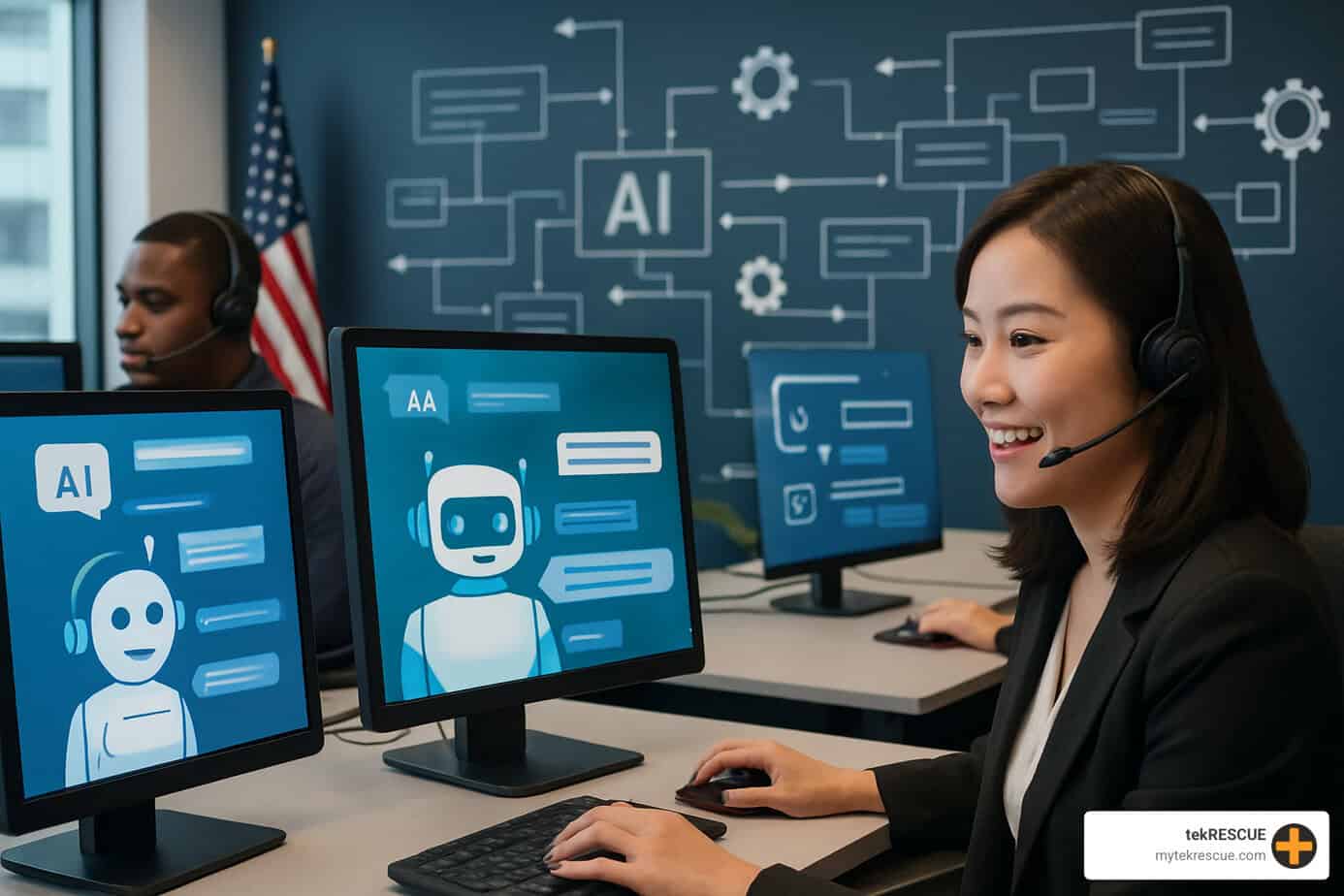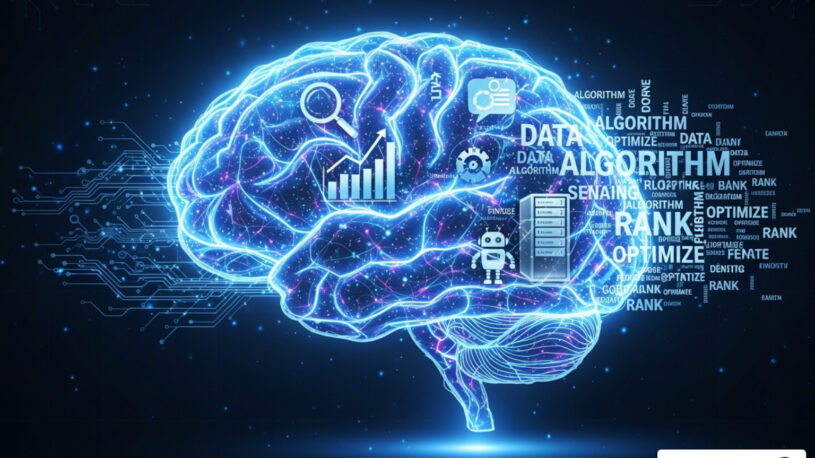

AI in Customer Service: Because Robots Can Be Friendly Too
The AI Revolution in Customer Service
AI for customer service is changing how businesses interact with their customers, providing 24/7 support, faster resolutions, and personalized experiences. If you’re looking to implement AI in your customer service operations, here’s what you need to know:
| Key Benefits of AI for Customer Service | How It Works |
|---|---|
| ✓ 24/7 availability without staffing costs | Uses natural language processing to understand customer queries |
| ✓ Can handle up to 80% of routine inquiries | Integrates with existing knowledge bases and CRM systems |
| ✓ Reduces response times by up to 70% | Learns and improves from each interaction |
| ✓ Increases customer satisfaction by 15-25% | Routes complex issues to human agents when necessary |
| ✓ Lowers operational costs by 30-40% | Collects data to provide insights for business improvement |
Today’s customers expect instant, personalized support at any hour. When they don’t get it, they leave—80% of customers will switch to a competitor after more than one bad experience. This is where AI steps in to transform your customer service from a cost center into a competitive advantage.
AI-powered customer service isn’t just about chatbots. Modern solutions include virtual assistants, sentiment analysis, predictive analytics, and intelligent routing systems that work together to create seamless customer experiences. By automating routine inquiries, businesses can free up human agents to handle complex issues that require empathy and critical thinking.
I’m Randy Bryan, founder of tekRESCUE, and I help businesses implement AI for customer service solutions that balance automation with the human touch their customers deserve. My expertise in AI and cybersecurity ensures that your customer service technology is both effective and secure.

Basic ai for customer service glossary:
AI for Customer Service 101
When we talk about AI for customer service, we’re referring to technologies that make customer interactions smoother, faster, and more effective. At its heart, these technologies help businesses provide better support while saving time and resources.
Natural Language Processing (NLP) is what allows AI to understand when a customer types “Where’s my stuff?” instead of the more formal “Please provide the status of my order.” It’s like having a translator that converts human speech into something computers can work with – and then translates the computer’s response back into natural-sounding human language.
Machine Learning gives these systems their impressive ability to get better over time. Imagine a new employee who remembers every single customer interaction and learns from each one. That’s what machine learning does – it notices patterns and improves its responses based on what worked well in the past.
Large Language Models have really changed the game in recent years. These sophisticated AI systems (like GPT-4) can handle complex conversations that would have stumped earlier chatbots. They maintain context throughout a conversation and generate responses that feel much more natural and helpful.
Sentiment Analysis is another fascinating capability – it’s like emotional intelligence for AI. By analyzing word choice, tone, and language patterns, AI can detect when a customer is frustrated or delighted, allowing it to adjust its approach or hand things off to a human when emotions are running high.
Research published in the Journal of Retailing and Consumer Services confirms what many of us intuitively know – customers appreciate chatbots that feel somewhat human-like in their interactions (while being transparent about being AI) and that actually solve their problems efficiently. When these conditions are met, satisfaction rates climb significantly.
At tekRESCUE, we incorporate these technologies into our AI Business Process Automation services to create support experiences that feel natural while delivering impressive results.
Main Benefits of AI for Customer Service
The advantages of implementing AI for customer service extend to both your customers and your bottom line:
Speed and Availability might be the most immediately obvious benefit. While your human team needs to sleep, AI systems can provide instant answers 24 hours a day, 365 days a year. Industry data shows that chatbots can handle up to 80% of routine questions without human intervention. This round-the-clock support is especially valuable if you serve customers across different time zones.
Cost Savings and Efficiency are significant motivators for many businesses. By automating routine inquiries, companies typically reduce operational costs by 30-40%. Your AI assistants can handle multiple conversations simultaneously, require no training for basic inquiries, and process simple requests in seconds rather than minutes.
Improved Productivity for your human support team is another major advantage. When AI handles the repetitive questions (“What are your hours?” “How do I reset my password?”), your team members can focus on complex issues that require human empathy, judgment, and creative problem-solving. Studies show support agent productivity increases by approximately 14% with AI assistance.
Improved Customer Satisfaction might seem counterintuitive – don’t people prefer human support? The data suggests otherwise, with CSAT scores improving 15-25% after AI implementation. When customers get immediate answers to simple questions instead of waiting on hold, their satisfaction naturally increases.
Data-Driven Insights represent a hidden treasure in AI customer service. These systems continuously collect information about what customers are asking, what problems they’re encountering, and how satisfied they are with solutions. This wealth of data helps you identify product issues, information gaps, and improvement opportunities you might otherwise miss.
Scalability becomes much simpler with AI in your support mix. During seasonal peaks or unexpected surges in customer inquiries, your AI system can handle the increased volume without the need to rapidly hire and train new staff.
Omnichannel Support ensures customers receive consistent help whether they reach out via your website, mobile app, social media, email, text message, or phone. This seamless experience across channels has become an expectation for modern consumers.
Common Applications of AI for Customer Service
AI for customer service shows up in several practical applications that businesses are using today:
Chatbots and Virtual Assistants are probably the most familiar face of AI customer service. These text-based helpers engage with customers on websites, apps, and messaging platforms. They can answer common questions, provide product details, help with simple transactions, and collect information before handing off to a human agent when necessary.
Sephora’s beauty bot offers a real-world example of effective implementation. According to a case study by Cut-the-SaaS, their chatbot helps customers find the right products based on their preferences and skin type, while also booking in-store appointments – increasing booking rates by 11%.
Voice Bots and IVR Systems bring AI capabilities to phone support. These systems understand spoken requests, provide verbal responses, and can handle many tasks that previously required a human operator. Modern voice AI goes far beyond the frustrating “press 1 for sales” systems of the past, allowing for natural conversation and more complex interactions.

Intelligent Routing and Prioritization ensures that customer inquiries get to the right place quickly. AI analyzes the content of messages to determine the issue type, urgency, and complexity. It can then route each inquiry to the most appropriate agent based on expertise and availability. This means customers spend less time being transferred between departments and more time getting their issues resolved.
Predictive Analytics and Proactive Support shift customer service from reactive to proactive. By analyzing patterns and historical data, AI can often spot potential problems before customers do. For example, a telecommunications provider might use AI to detect network issues and proactively contact affected customers with updates and workarounds.
AI-Powered Knowledge Bases make self-service more effective. These systems can automatically create and update help articles, suggest relevant resources based on customer behavior, and identify gaps in your knowledge base content. This means customers can often find answers without needing to contact support at all.
Recommendation Engines personalize the customer experience by suggesting relevant products, support articles, or solutions based on the customer’s history and preferences. When done well, these recommendations feel helpful rather than pushy, adding genuine value to the customer experience.
Here in Texas, businesses from San Antonio to Dallas and to Houston are increasingly adopting these AI applications to stay competitive in a market where customer expectations continue to rise.
How AI for Customer Service Works Behind the Scenes
Understanding the technical side of AI for customer service helps you make smarter implementation decisions:
Natural Language Understanding (NLU) Pipelines process customer messages through several sophisticated steps. First, the system cleans and normalizes the text by correcting spelling errors and standardizing format. Then it identifies the customer’s intent – what they’re trying to accomplish. Next, it extracts specific information like order numbers or product names. Throughout this process, it maintains conversation context and finally generates an appropriate response.
Retrieval-Augmented Generation (RAG) combines two powerful approaches for more accurate responses. The retrieval component searches through your knowledge base, FAQs, and documentation to find relevant information. The generation component then creates a conversational response using this retrieved information as a foundation. This hybrid approach helps prevent AI from “making up” incorrect answers – a critical factor in maintaining customer trust.

Reinforcement Learning from Human Feedback is how these systems improve over time. Human agents review and correct AI responses, providing feedback that helps the system learn. The AI also analyzes successful and unsuccessful interactions to identify patterns and improvement opportunities. This continuous learning process means your AI customer service becomes more effective the longer you use it.
Integrations and APIs connect your AI system with other business tools. These connections allow the AI to access customer history from your CRM, check order status in your management system, retrieve accurate information from your knowledge base, verify customer identity securely, and feed interaction data to your analytics platforms. Without these integrations, AI would be limited to generic responses rather than personalized, account-specific assistance.
At tekRESCUE, we ensure these technical components work together seamlessly while maintaining robust security. For businesses throughout Central Texas and beyond, we design AI customer service solutions that protect sensitive data while delivering exceptional customer experiences.
Implementing & Optimizing AI Support
Bringing AI for customer service into your business isn’t just about buying new software—it’s about thoughtfully integrating technology that complements your team’s strengths. Let’s walk through how to make this transition smooth and successful.
When we help businesses implement AI at tekRESCUE, we always start with a clear roadmap. This means taking stock of your current customer service operations, identifying the pain points that frustrate both your team and customers, and setting specific goals. What does success look like for you? Maybe it’s reducing wait times, extending support hours, or freeing up your specialists to handle complex cases.
Once you have clear objectives, prioritize the simplest use cases first. Order status inquiries, password resets, and frequently asked questions make excellent starting points because they’re high-volume but straightforward. This creates quick wins that build confidence throughout your organization.
Technology selection comes next, and this is where many businesses stumble. The right AI solution needs to work with your existing systems, meet your security requirements, and align with your specific business needs. We typically recommend starting with a pilot program—a small-scale implementation that lets you test and refine before rolling out widely.
Getting Everyone on Board
Your AI implementation will only succeed if your team accepts it. This means securing buy-in from:
Your leadership team needs to see the ROI and strategic advantages. Your customer service agents need reassurance that AI will make their jobs better, not replace them. Your IT department needs confidence in the security and integration capabilities. And most importantly, your customers need to understand how this technology will improve their experience.
We’ve found that transparency works wonders here. When teams understand how AI will help them—not replace them—resistance typically melts away. In fact, according to Zendesk’s 2024 report, more than two-thirds of customer experience organizations agree that AI can actually help businesses provide the warm, familiar service interactions that build loyalty.
Finding the Right Balance
Not every customer interaction should be handled by AI. The trick is knowing which approach works best in different scenarios:
For routine inquiries where speed matters most, an AI-first approach makes sense. When emotions run high or situations get complex, a human-first approach is still best. But the most effective strategy is often a hybrid approach—using AI to gather information and suggest solutions, with humans making final decisions or handling sensitive aspects of the conversation.
This balanced approach gives you the best of both worlds: the efficiency and consistency of AI with the empathy and judgment of your team members.
Keeping Data Safe and Building Trust
As AI systems process sensitive customer information, robust security measures aren’t optional—they’re essential. This includes collecting only necessary data, encrypting information both in transit and at rest, implementing strict access controls, and ensuring compliance with regulations like GDPR and CCPA.
At tekRESCUE, we take this aspect very seriously. Our expertise in Managing the Cybersecurity Vulnerabilities of Artificial Intelligence helps businesses implement AI without creating security risks.
Building customer trust requires transparency about when they’re interacting with AI, consistency in the information provided, easy paths to reach humans when needed, and continuous improvement based on feedback. When customers see that you’re using AI to serve them better—not just cut costs—acceptance follows naturally.
Best Practices: From Pilot to Scale
Starting small and scaling strategically gives your AI implementation the best chance of success. Begin with those high-volume, low-complexity cases we mentioned earlier. These should be well-documented with clear resolution paths and measurable outcomes.
The quality of your data dramatically impacts your results. Your AI is only as good as what it learns from, so ensure your knowledge base is accurate, up-to-date, and well-organized. Include various ways customers might phrase the same question, and establish processes to keep information current as products and policies change.
Keep humans in the loop through supervised learning, regular quality checks, clear escalation protocols, and feedback mechanisms. This human oversight helps your AI system improve continuously while catching any issues before they impact customers.
For businesses serving diverse communities—like we do across Texas—consider multilingual capabilities and cultural nuances in communication. An AI that understands regional terminology and respects cultural differences will connect more effectively with your entire customer base.
Measuring ROI and Success
The investment in AI for customer service needs to show clear returns. Track metrics in three key areas:
Cost savings come from reduced cost per interaction, decreased staffing requirements for routine inquiries, lower training costs, and reduced overtime during peak periods.
Efficiency improvements show up as decreased resolution times, higher first-contact resolution rates, improved agent productivity, and smaller ticket backlogs.
Revenue impact manifests through better customer retention, increased cross-sell opportunities, higher Net Promoter Scores, and expanded service hours without proportional cost increases.
When comparing human-only support to AI-augmented approaches, the differences are striking:
| Metric | Human-Only Support | AI-Augmented Support | Improvement |
|---|---|---|---|
| Cost per ticket | $15-25 | $1-5 for AI-resolved $10-15 for AI-assisted | 40-80% reduction |
| Average response time | 24 hours | 5 minutes | 99% reduction |
| Tickets per agent per day | 20-30 | 50-70 | 100-150% increase |
| After-hours coverage | Limited or costly | 24/7 at consistent cost | Significant improvement |
| Customer satisfaction | Varies with wait times | Consistent with instant responses | 15-25% improvement |
Some benefits appear immediately, like reduced response times and extended service hours. Others develop over months, including improved agent productivity and data-driven insights that continue to improve your operations.
Challenges & Limitations
Being realistic about AI for customer service means acknowledging its limitations. AI systems sometimes generate plausible-sounding but incorrect information—what’s often called “hallucinations.” Mitigate this by grounding AI responses in verified knowledge bases, setting confidence thresholds, creating clear escalation paths, and regularly auditing responses.
Bias concerns arise when AI systems inadvertently perpetuate biases in their training data. Address this through diverse training data, regular testing, fairness metrics, and oversight committees to review AI decisions.
Regulatory compliance spans data privacy laws, disclosure requirements about AI interactions, record-keeping obligations, and accessibility standards. Staying on top of these requirements prevents costly missteps.
Many businesses struggle with integrating AI into legacy systems. Overcome this by thoroughly inventorying your systems before implementation, using middleware or API layers to bridge compatibility gaps, and considering phased approaches to modernization.

Some customers still prefer human support, especially for complex or emotional issues. Respect this by offering clear options to reach human agents, using AI to identify emotional cues that warrant human intervention, and creating seamless transitions between AI and human support. When these handoffs happen, transfer context and conversation history so customers don’t have to repeat themselves.
Future Trends Shaping AI for Customer Service
The AI landscape evolves rapidly, with several exciting developments on the horizon. Generative AI models like GPT-4 are enabling more natural, conversational interactions and creative problem-solving approaches. Gartner predicts that 80% of customer service organizations will soon apply generative AI to improve customer experiences.
Autonomous AI agents represent the next generation—systems that operate end-to-end without human prompts, self-improve through continuous learning, and proactively identify customer needs before they’re expressed.
Multimodal experiences are expanding beyond text to include visual recognition, voice analysis, and even augmented reality troubleshooting. Imagine a customer showing a malfunctioning product to an AI via their smartphone camera and receiving visual repair instructions in real time.
Proactive support will increasingly anticipate customer needs before they reach out, identify potential issues based on usage patterns, and recommend preventive actions at just the right moment.
Hyper-personalization will create custom interactions based on comprehensive customer profiles, adapting communication styles to match preferences and offering solutions custom to individual history.
At tekRESCUE, we help Texas businesses implement AI for Process Improvement that incorporates these forward-looking trends while ensuring practical, immediate benefits. The future of customer service is both more automated and more personal—and we’re excited to help you steer this change.
Conclusion & Next Steps
The journey to implementing AI for customer service might seem daunting at first, but the rewards make it worthwhile. Throughout this guide, we’ve seen that AI isn’t about replacing your human team – it’s about enhancing their capabilities to deliver truly exceptional customer experiences.
For businesses in Texas and beyond, the time to accept AI for customer service is now. Customer expectations continue to rise each year, and companies that hesitate risk falling behind competitors who are already using AI to provide faster, more personalized support.
At tekRESCUE, we understand that every business has unique customer service challenges. Your boutique retail store in San Antonio has different needs than a software company in Dallas or a healthcare provider in Austin. That’s why our approach to AI implementation is custom to your specific goals, existing systems, and customer base.
Our team serves businesses across Central Texas, DFW, San Antonio, and beyond with Strategic AI Consulting that ensures your AI deployment is secure, effective, and perfectly aligned with your business objectives. We don’t just implement technology – we help you transform your customer experience.
What sets us apart is our dual expertise in both AI and cybersecurity. This unique combination means we can help you steer technical complexities while ensuring your valuable customer data remains protected. We focus on practical solutions that deliver measurable results, whether you’re looking to implement your first chatbot or build a comprehensive AI-powered customer service ecosystem.
Ready to transform your customer service with AI? Here’s how to get started:
First, let us evaluate your current customer service operations to identify the best opportunities for AI improvement. Then, we’ll work together to create a custom implementation roadmap that makes sense for your business. Once we have a plan, we’ll help you deploy AI solutions with built-in security and privacy protections. Finally, we’ll help you continuously refine your AI capabilities based on performance data and customer feedback.
To learn more about how tekRESCUE can help you leverage AI for customer service, explore our Strategic AI Consulting services or reach out to us today. Together, we’ll build a customer service experience that delights your customers while driving sustainable business growth.
In customer service, robots can indeed be friendly too—especially when they’re designed to complement your human team and deliver the exceptional support your customers deserve.
Table of Contents









